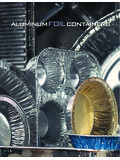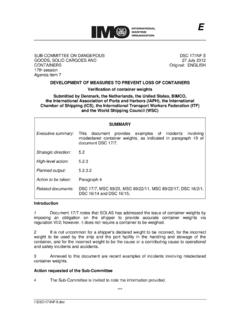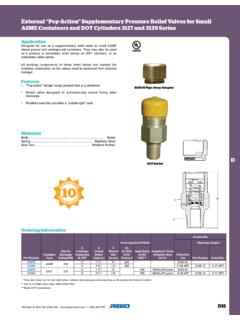Transcription of Qualification of shipping containers - WHO
1 ` Supplement 13 WHO Vaccine Qualification of shipping containers Technical supplement to WHO Technical Report Series, No. 961, 2011 Annex 9: Model guidance for the storage and transport of time and temperature sensitive pharmaceutical products August 2014 World Health Organization 2014 WHO Press, World Health Organization, 20 Avenue Appia, 1211 Geneva 27, Switzerland (tel.: +41 22 791 3264; fax: +41 22 791 4857; e-mail: Requests for permission to reproduce or translate WHO publications whether for sale or for noncommercial distribution should be addressed to WHO Press, at the above address (fax: +41 22 791 4806; e-mail: The designations employed and the presentation of the material in this publication do not imply the expression of any opinion whatsoever on the part of the World Health Organization concerning the legal status of any country, territory, city or area or of its authorities, or concerning the delimitation of its frontiers or boundaries.))
2 Dotted lines on maps represent approximate border lines for which there may not yet be full agreement. The mention of specific companies or of certain manufacturers products does not imply that they are endorsed or recommended by the World Health Organization in preference to others of a similar nature that are not mentioned. Errors and omissions excepted, the names of proprietary products are distinguished by initial capital letters. All reasonable precautions have been taken by the World Health Organization to verify the information contained in this publication. However, the published material is being distributed without warranty of any kind, either expressed or implied.
3 The responsibility for the interpretation and use of the material lies with the reader. In no event shall the World ` Health Organization be liable for damages arising from its use. The named authors alone are responsible for the views expressed in this publication. Technical Supplement: Qualification of shipping containers 3 Acknowledgments The authors of this document are Kevin O Donnell, Exelsius Cold Chain Management Consultancy and member of the United States Pharmacopeia Expert Committee on Packaging, Storage and Distribution, 2010-2015 cycle, Ben VanderPlas, Sonoco ThermoSafe and Bill Mayer, Minnesota Thermal Science. Technical Supplement: Qualification of shipping containers 4 Contents Acknowledgments.
4 3 Contents .. 4 Abbreviations .. 5 Glossary .. 6 1. Introduction .. 10 Requirements .. 10 12 Target readership .. 12 2. Guidance .. 13 The three stages of Qualification .. 13 Design Qualification .. 13 Operational Qualification .. 14 Performance Qualification .. 14 Re- Qualification of reusable container systems .. 15 Associated materials and equipment .. 15 Test equipment for design and operational qualifications .. 15 Test equipment for performance Qualification .. 16 The performance Qualification test protocol .. 16 Protocol title .. 16 Protocol approvals .. 16 Introduction .. 16 16 Scope .. 17 Acceptance criteria .. 17 Responsibilities.
5 17 Test procedure .. 17 Data analysis .. 17 The performance Qualification test .. 18 The performance Qualification report .. 21 References .. 22 Revision history .. 23 Technical Supplement: Qualification of shipping containers 5 Abbreviations ASTM American Society for Testing and Materials DQ Design Qualification EDLM Electronic Data Logging Monitor ISPE International Society for Pharmaceutical Engineering ISTA International Safe Transit Association OQ Operational Qualification PDA Parenteral Drug Association PQ Performance Qualification SOP Standard Operating Procedure TTSPP Time and Temperature-Sensitive Pharmaceutical Product URS User Requirement Specification Technical Supplement: Qualification of shipping containers 6 Glossary Active systems.
6 Externally powered or on-board powered systems using electricity or other fuel source to maintain a temperature-controlled environment inside an insulated enclosure under thermostatic regulation ( cold rooms, refrigerators, temperature-controlled trucks, refrigerated ocean and air containers ). Advanced Phase Change Materials (PCMs): Temperature stabilizing media (sometimes referred to as refrigerants), chemically engineered so that their latent heat of fusion occurs at a temperature other than zero C, phasing from one state of matter to another ( liquid to solid) at a pre-formulated temperature. Such materials are typically comprised of oils, salts, or paraffin.
7 Ancillary packaging components: Packaging elements used to protect the TTSPP and support or enhance performance of the completed package. This may include retainers, dunnage, secondary protective packaging, and temperature data logging devices. Associated components: Articles of packaging that are typically intended to deliver the dosage form to the patient but are not stored in contact with the dosage form for its entire shelf life. These components are packaged separately in the market package and are either attached to the container upon opening or used only when a dose is to be administered. Examples: measuring spoons, dosing cups, measuring syringes. Cryogenic dry/vapour shipper: A temperature-controlled insulated packaging container or system compatible with liquefied gasses such as nitrogen used for maintaining extremely low temperatures during shipping .
8 A porous medium internal to the shipping container absorbs and contains all the free flowing liquid and does not allow it to come in contact with the product a process known as charging . A fully charged and undamaged dry/vapour shipper containing nitrogen can maintain -196 C for up to 10 days, depending on the unit size. Design Qualification : The process of obtaining a nd documenting evidence that the premises, equipment and supporting systems and processes have been designed in accordance with the requirements for Good Manufacturing Practices (GMP)1. Dunnage: Loose packing material used to protect TTSPPs from damage during transport. Electronic Data Logging Monitor (EDLM): A small portable device that measures and stores temperature at a pre-determined time intervals by means of an electronic sensor.
9 They have programmable alarm capabilities, integrated displays, and can create reports and graphs which may be permanently stored, shared and analysed via proprietary hardware, software, desktop application or through hosted databases. Electronic temperature monitoring and event logger system (EDLM): System for recording and reporting air and/or product temperatures, with optional facilities for recording and reporting specific events such as door-opening or defrost cycles, and for issuing alarms. Such systems may be user-programmable and may also be remotely monitored via a satellite link. 1 WHO Technical Report Series, No.
10 961, 2011. Annex 3: WHO good manufacturing practices for pharmaceutical products: main principles. Technical Supplement: Qualification of shipping containers 7 External distribution: Transport of TTSPPs through various steps in the customer s supply chain ( transport from a pharmaceutical manufacturer s distribution centre, to commercial customers (including wholesalers, retailers and buying groups), to clinical facilities or direct to the patient). Contrast with internal distribution. Installation Qualification (IQ): The process of obtaining and documenting evidence that the premises, equipment and supporting systems have been provided and installed in compliance with their design specifications.
















